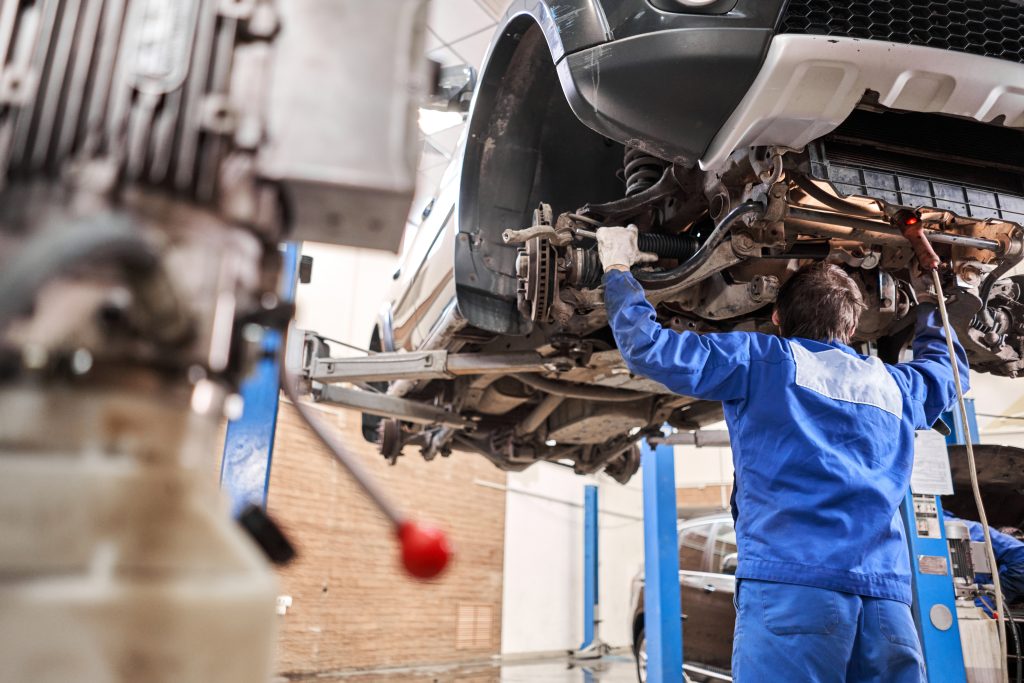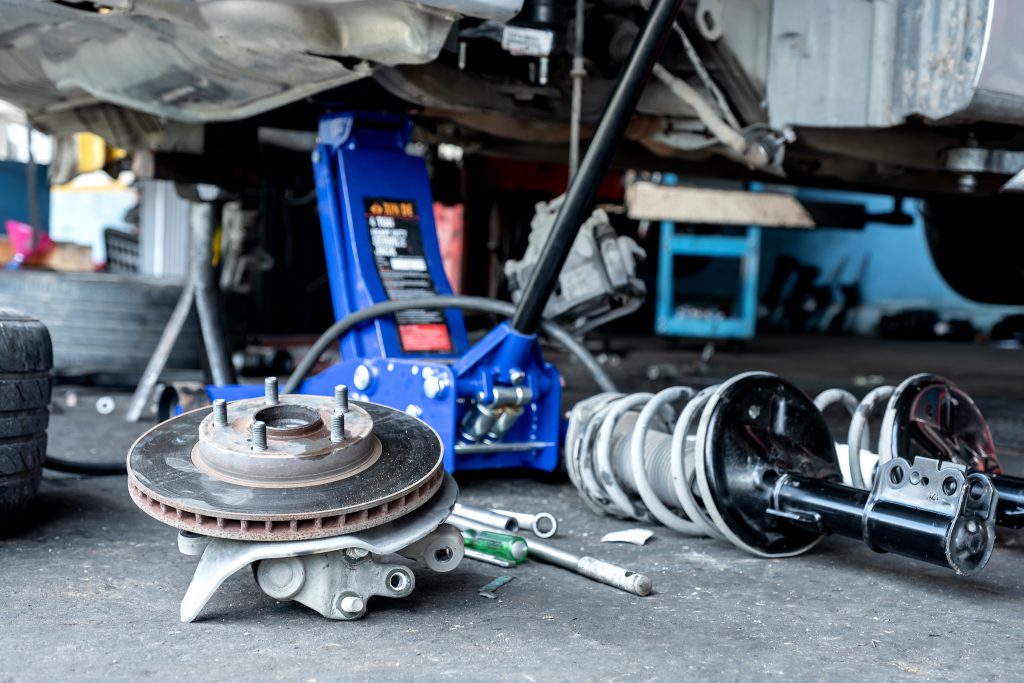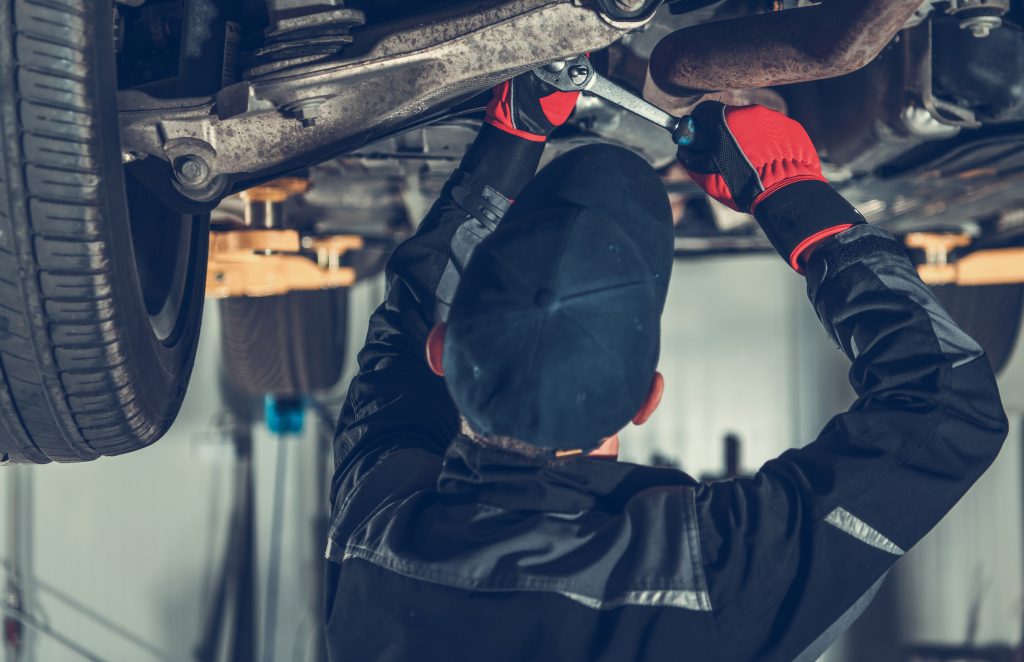When to Replace vs. Repair Your Car’s Suspension
- Harbor Brakes
- May 7, 2024
- Uncategorized
A damaged or deteriorating suspension can not only make your vehicle unmanageable but also make it dangerous to drive. The suspension system in your car allows you to control the car’s direction and movement. It keeps the tires in contact with the road surface and ensures effective steering, driving, and braking. The suspension absorbs shocks from bumps and potholes, providing a comfortable journey. Signs that your suspension needs repair or replacement include pulling to one side, excessive bouncing, uneven vehicle height, and poor braking performance.
Key Takeaways:
- A damaged suspension can compromise your vehicle’s safety and drivability.
- Signs of suspension trouble include pulling to one side, excessive bouncing, uneven vehicle height, and poor braking performance.
- Regular maintenance is essential to ensure optimal suspension performance and extend its lifespan.
- Consult with a trusted mechanic to determine the best course of action for repair or replacement.
- Upgrading your suspension can improve handling, performance, and ride quality.
Understanding Car Suspension Components
A car’s suspension is composed of various components that work together to ensure a smooth and comfortable ride. These components include springs, shocks, struts, ball joints, tie rod ends, sway bar end links, control arms, and more.
The primary function of car suspension is to absorb shocks and vibrations from the road, maintain vehicle stability, and ensure optimal handling. By keeping the tires in contact with the road surface, the suspension plays a vital role in steering, driving, and braking.
Types of Car Suspension
There are different types of car suspension systems, each with its own advantages and disadvantages. Some of the common types include:
- Independent Suspension: This type of suspension allows each wheel to move independently, offering a smoother ride and better traction. It provides better control and stability, especially during cornering.
- Solid Axle Suspension: Solid axle suspension connects both wheels on an axle, allowing them to move together. It is commonly found in trucks and SUVs and provides excellent load-carrying capability but may sacrifice ride comfort.

Understanding the role of each suspension component is essential in diagnosing and maintaining the system’s overall performance. Additionally, these components undergo wear and tear over time and may require replacement to ensure optimal suspension functionality.
Key Suspension Components
Let’s take a closer look at some of the key suspension components:
- Springs: These components support the weight of the vehicle and help absorb shocks and vibrations from the road. They come in different types, such as coil springs and leaf springs, depending on the vehicle’s design.
- Shocks and Struts: These components help control the movement of the springs, damping oscillations, and preventing excessive bouncing. Shocks are typically used in vehicles with separate suspension components, while struts combine the spring and shock absorber into a single unit.
- Ball Joints and Tie Rod Ends: These components connect various suspension parts, allowing for movement, while maintaining stability and control. Ball joints connect the control arms to the steering knuckles, while tie rod ends connect the steering linkage to the steering knuckles.
- Sway Bar End Links: Sway bars, also known as stabilizer bars, help control body roll during cornering. Sway bar end links connect the sway bar to the suspension components.
- Control Arms: Control arms connect the suspension system to the vehicle frame, allowing for up-and-down movement of the wheels. They help maintain wheel alignment and provide stability.
| Component | Description |
|---|---|
| Spring | Supports the weight and absorbs shocks |
| Shock Absorber | Damps oscillations and prevents excessive bouncing |
These are just a few examples of the many components that make up a car’s suspension system. Each component plays a crucial role in maintaining stability, absorbing shocks, and providing a comfortable ride. Regular inspection and maintenance of these components are essential to ensure optimal suspension performance and extend their lifespan.
Importance of Car Suspension Maintenance
Regular maintenance of your car’s suspension is crucial for optimal performance and safety. Taking care of your suspension system helps ensure that all the components are in good condition, reducing the risk of accidents and damage to other parts of the car. It also plays a vital role in providing a comfortable ride and improving vehicle handling.
Proper car suspension maintenance includes a range of tasks that help keep the system functioning at its best. Regularly inspecting and replacing worn-out components, aligning the wheels, inspecting for leaks or damage, and maintaining proper tire pressure are some of the essential maintenance tasks for your car’s suspension.
By maintaining your car’s suspension, you can extend its lifespan and prevent costly repairs in the long run. Regular suspension maintenance not only ensures a smoother and safer ride but also helps optimize the overall performance of your vehicle.
Signs of Worn-Out Suspension
Recognizing the signs of worn-out suspension is essential to determine when repair or replacement is necessary for your vehicle’s safety and performance. Below are some common signs that indicate potential suspension issues:
- Steering Difficulties: Difficulty in turning the steering wheel or a feeling of it pulling to one side can indicate worn-out suspension components.
- Excessive Bouncing or Vibration: If you experience a bumpy or shaky ride even on smooth roads, it may be a sign of worn-out shocks or struts.
- Uneven Tire Wear: Uneven wear patterns on your tires, such as bald patches or uneven tread depth, can be caused by unbalanced or damaged suspension components.
- Vehicle Leaning to One Side: If your vehicle leans noticeably to one side when cornering or driving straight, it may indicate a worn-out suspension.
- Unusual Noises: Unusual noises, such as clunking or creaking sounds when driving over bumps or rough surfaces, can be a sign of worn-out suspension components.
- Decreased Braking Performance: If you notice a decrease in braking performance, such as a longer stopping distance or difficulty in controlling the vehicle during braking, it could be due to worn-out suspension components affecting the braking system.

If you observe any of these signs, it’s crucial to have your suspension system inspected by a qualified mechanic as soon as possible. Ignoring these signs can lead to further damage and compromise your safety on the road.
| Signs of Worn-Out Suspension | Possible Causes |
|---|---|
| Steering Difficulties | Worn-out ball joints, tie rod ends, or control arms |
| Excessive Bouncing or Vibration | Worn-out shocks or struts |
| Uneven Tire Wear | Unbalanced suspension components or misaligned wheels |
| Vehicle Leaning to One Side | Worn-out springs or damaged suspension components |
| Unusual Noises | Worn-out bushings, ball joints, or mounts |
| Decreased Braking Performance | Worn-out shocks, struts, or other suspension components affecting the braking system |
Identifying these signs and taking prompt action can help maintain your vehicle’s performance and ensure your safety on the road.
Car Suspension Repair or Replacement: Factors to Consider
When it comes to your car’s suspension, making the decision between repair and replacement is not always straightforward. Several factors need to be considered to ensure you choose the most suitable option for your vehicle. These factors include:
- The extent of the damage: Assess the severity of the damage to your suspension system. If it’s limited to a specific component or two, such as worn-out shocks or struts, repairing them may be a viable option.
- Availability of replacement parts: Availability can play a crucial role in determining whether repair or replacement is feasible. If finding replacement parts for your suspension system is challenging or costly, it may be more practical to opt for a full replacement.
- Overall condition of the suspension system: Consider the overall condition of your suspension system. If multiple components are worn or damaged, it may indicate a decline in the system’s integrity. In such cases, a complete replacement can provide a more effective and long-term solution.
It is recommended to consult with a trusted mechanic or suspension specialist to assess the condition of your suspension system and determine the most cost-effective and safe solution. Their expertise will help guide you in making an informed decision that meets your vehicle’s needs and your budget.
Upgrading Your Car Suspension
Upgrading your car’s suspension can significantly enhance its handling, performance, and ride quality. By investing in a car suspension upgrade, you can enjoy a smoother and more comfortable driving experience. Whether you want to improve cornering ability, reduce body roll during dynamic driving, or achieve a sportier feel, upgrading your car’s suspension can make a noticeable difference.
There are various options for upgrading your car’s suspension, depending on your specific needs and preferences. Some popular upgrades include:
- High-performance shocks or struts: Upgrading to high-performance shocks or struts can improve your car’s overall suspension performance, resulting in better control and stability.
- Adjustable components: Upgrading to adjustable components allows you to fine-tune your suspension settings, giving you more control and flexibility for different driving conditions and preferences.
- Replacing worn-out parts: If certain components of your suspension system are worn out, replacing them with higher-quality options can improve the overall performance and longevity of your suspension.
When considering a car suspension upgrade, it’s important to ensure compatibility with your specific vehicle make and model. Consulting with a suspension specialist or auto mechanic can help you make informed decisions and choose the right upgrades for your car.
Suspension Repair Costs and Estimates
When it comes to repairing your car’s suspension, the costs can vary depending on the extent of the damage and the specific components that need replacement. It’s important to be aware of these factors to get a better understanding of the potential expense involved in suspension repairs.
Minor suspension repairs, such as replacing worn-out shocks or struts, can typically cost a few hundred dollars. However, more extensive repairs or a complete suspension system replacement can run into the thousands of dollars.
The actual cost of suspension repairs also depends on several other factors:
- Labor Charges: The amount of labor required for the repair job can significantly impact the overall cost. Labor rates can vary between different repair centers, so it’s essential to consider this when obtaining estimates.
- Parts Pricing: The cost of suspension components can vary based on the make and model of your vehicle, as well as the quality of the replacement parts chosen.
- Dealership or Independent Mechanic Rates: Dealerships often have higher labor rates compared to independent mechanics, so it’s worth exploring different repair centers to find competitive pricing.
To ensure you’re getting a fair price for the necessary repairs, it’s advisable to obtain multiple estimates from reputable repair centers. This will allow you to compare prices and make an informed decision about which one offers the best value for your suspension repair needs.

Regular Suspension Maintenance Tips
Proper maintenance is essential to ensure the longevity and optimal performance of your car’s suspension system. By following these maintenance tips, you can keep your suspension in top shape:
- Regularly inspect for wear or damage: Routinely check your suspension components for any signs of wear, such as leaking fluids, cracks, or excessive rust. Pay attention to the condition of the springs, shocks, struts, and control arms.
- Check fluid levels in shock absorbers: Check the fluid levels in your shock absorbers periodically and make sure they are within the recommended range. Low fluid levels can affect the performance of your suspension system.
- Keep suspension components clean: Clean your suspension components regularly to remove dirt, debris, and road salt that can contribute to corrosion and damage. Use a gentle cleanser and rinse thoroughly.
- Follow recommended maintenance schedules: Refer to your vehicle’s manufacturer recommendations for scheduled maintenance tasks specific to your suspension system. Adhering to these schedules can help catch potential issues early on.
- Practice safe driving habits: Avoid rough roads, potholes, and other hazards whenever possible. These can put unnecessary stress on your suspension system and lead to accelerated wear and damage.
- Mindful of weight limits: Be mindful of the weight limits specified for your vehicle. Overloading your car can strain the suspension and negatively affect its performance.
By incorporating these maintenance practices into your routine, you can ensure that your car’s suspension performs optimally for a prolonged period, providing you with a smooth and comfortable ride.
| Maintenance Tips | Benefits |
|---|---|
| Regular inspections | Identify wear and damage early |
| Checking fluid levels | Optimal shock absorber performance |
| Keeping components clean | Prevents corrosion and damage |
| Following maintenance schedules | Timely detection of issues |
| Safe driving habits | Reduced stress on suspension system |
| Mindful of weight limits | Preserves suspension integrity |
Conclusion
Maintaining and repairing your car’s suspension system is vital for your safety, comfort, and overall vehicle performance. Regular inspections, timely repairs, and proper maintenance will help keep your suspension in excellent condition and extend its lifespan. By addressing any signs of worn-out suspension promptly, you can avoid further damage and ensure a smooth and safe ride in your vehicle.
Whether you choose to repair or replace your suspension, it’s important to consult with a trusted mechanic who can assess the extent of the damage and provide an appropriate solution. Consider various factors such as the availability of replacement parts and the overall condition of your suspension system to make a cost-effective and reliable decision.
Remember, prioritizing suspension maintenance not only enhances your driving experience but also helps prevent costly repairs in the future. By taking care of your car’s suspension, you can enjoy optimal performance, improved vehicle handling, and a comfortable journey on the road. So make sure to give your suspension the attention it deserves and prioritize its regular maintenance.
FAQ
When should I replace my car’s suspension instead of repairing it?
The decision to replace or repair your car’s suspension depends on factors such as the extent of the damage, availability of replacement parts, and overall condition of the suspension system. Small repairs can often be done to restore functionality, but if multiple components are damaged or the system is severely worn, a complete replacement may be necessary.
What are the different components of a car’s suspension?
A car’s suspension system is made up of various components, including springs, shocks, struts, ball joints, tie rod ends, sway bar end links, and control arms. These components work together to absorb shocks, maintain vehicle stability, and provide a smooth ride.
Why is car suspension maintenance important?
Car suspension maintenance is crucial for optimal performance and safety. It helps ensure that suspension components are in good condition, reducing the risk of accidents and damage to other parts. It also promotes a comfortable ride and improves vehicle handling.
What are the signs of worn-out suspension?
Signs of worn-out suspension include pulling to one side, excessive bouncing, uneven vehicle height, and poor braking performance. Other signs may include steering difficulties, excessive vibration, uneven tire wear, vehicle leaning to one side, unusual noises when driving over bumps, and decreased braking performance.
How much does car suspension repair cost?
The cost of repairing your car’s suspension depends on the extent of the damage and the specific components that need replacement. Repair costs can range from a few hundred dollars for minor repairs to over a thousand dollars for extensive repairs or a complete suspension system replacement.
Can upgrading my car’s suspension improve its performance?
Yes, upgrading your car’s suspension can improve its handling, performance, and ride quality. Upgrades may include installing high-performance shocks or struts, upgrading to adjustable components for customizability, or replacing worn-out parts with higher-quality options.
What are some regular suspension maintenance tips?
Regular suspension maintenance tips include inspecting for signs of wear or damage, checking fluid levels in shock absorbers, keeping the suspension components clean, and following recommended maintenance schedules from the vehicle manufacturer. Safe driving habits and avoiding potholes and rough roads whenever possible also help reduce stress on the suspension system.
Why is proper suspension maintenance important?
Proper suspension maintenance is important as it helps keep your suspension in excellent condition, ensuring safety, comfort, and overall vehicle performance. Regular inspections, timely repairs, and following maintenance schedules will help extend the lifespan of your car’s suspension system.
